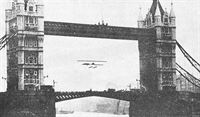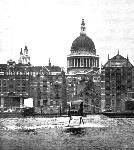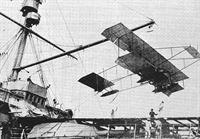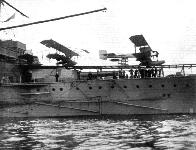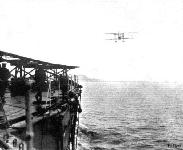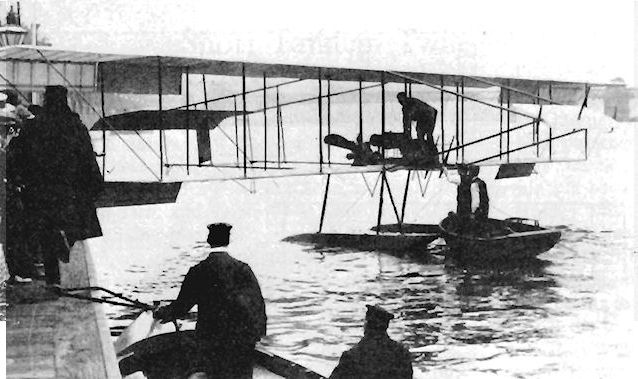
Описание
Страна: Великобритания
Год: 1912
Варианты
- Short - S.26 - S.29 / S.32 (Type S.27) - 1910 - Великобритания
- Short - S.34 / S.35 - 1911 - Великобритания
- Short - S.33 / S.38 seaplane - 1912 - Великобритания
- Short - S.38 / Admiralty No.3 - 1912 - Великобритания
- Short - S.80 / S.81 - 1913 - Великобритания
- C.Barnes Short Aircraft since 1900 (Putnam)
- M.Goodall, A.Tagg British Aircraft before the Great War (Schiffer)
- Журнал Flight
-
P.Lewis - British Aircraft 1809-1914 /Putnam/
F. K. McClean's modified Short S.33 (a dual control seaplane version of the S.27 type) at the Thames Embankment after his flight up the river on 10th August, 1912. S.43-S.44 were similar but landplanes.
-
C.Barnes - Short Aircraft since 1900 /Putnam/
Frank McClean flying through Tower Bridge in S.33 on 10 August, 1912.
-
Журнал - Flight за 1912 г.
WITHIN SIGHT OF ST. PAUL'S. - Mr. Frank K. McClean on his Short hydro-aeroplane on Sunday last. Mr. McClean, on his machine, is seen passing the point on the Thames at St. Paul's Cathedral, he keeping to the surface of the water owing to the restrictions of the police authorities, to which special regulations must, in a measure, be attributed the mishap which Mr. McClean suffered when, lower down the Thames, he endeavoured to take to the air at the point indicated by the police authorities.
-
M.Goodall, A.Tagg - British Aircraft before the Great War /Schiffer/
Short S.38 amphibian made the first takeoff from a British warship.
-
Журнал - Flight за 1912 г.
THE NAVY HYDRO-AEROPLANES. - Landing the Short monoplane and the Deperdussin machine in a lighter from the "Hibernia" at Lodmore. On the left Commander Samson after a flight on "S 38" on Lodmore ground.
-
C.Barnes - Short Aircraft since 1900 /Putnam/
S.38 being hoisted aboard H.M.S. Hibernia at Weymouth in May 1912.
-
Журнал - Flight за 1912 г.
THE NAVAL HYDRO-AEROPLANES AS SEEN FROM THE "HIBERNIA." - Hoisting "S.38" on to the "Hibernia," and on the left the machine in place on the special platform.
-
Журнал - Flight за 1912 г.
A front view of the hydro-aeroplane mother vessel, "Hibernia," with the Fleet at Weymouth, showing the Navy aeroplanes in place on the special launching platform.
-
O.Thetford - British Naval Aircraft since 1912 /Putnam/
A modified Short S.27 pusher biplane on the launching ramp of HMS Hibernia in May 1912.
-
Журнал - Flight за 1912 г.
The NAVY HYDRO-AEROPLANES. - A side view of the "Hibernia" showing the two hydro-aeroplanes on the launching platform especially constructed for this purpose.
Другие самолёты на фотографии: Short S.41 seaplane - Великобритания - 1912
-
C.Barnes - Short Aircraft since 1900 /Putnam/
S.38 and S.41 stowed on the runway of H.M.S. Hibernia at Weymouth in May 1912.
Другие самолёты на фотографии: Short S.41 seaplane - Великобритания - 1912
-
C.Barnes - Short Aircraft since 1900 /Putnam/
Commander Samson flying S.38 off the forecastle of H.M.S. Hibernia at Weymouth in May 1912.
-
Журнал - Flight за 1912 г.
Commander Samson, on "S 38," in flight for Lodmore after launching from the deck of the "Hibernia," when travelling at 15 knots an hour. Weymouth is seen in the distance.
C.Barnes Short Aircraft since 1900 (Putnam)
Short Pusher Biplanes (1910-14)
<...>
After the Territorial scheme ended, Frank McClean converted S.33 into a twin-float seaplane, which he began flying from the Swale at Harty Ferry on 31 May, 1912, mainly to obtain data for Horace Short on the design and rigging of floats to get the best take-off performance. The floats were flat-bottomed pontoons without steps, having wooden frames covered with waterproofed canvas and internally braced with piano wire; at first they were reluctant to unstick from smooth water, but soon the correct setting was discovered, and by 9 June McClean had learned the knack of taking off even with a passenger aboard. On 10 August the Daily Mail had widely advertised their arrangements for the arrival on a French seaplane of the famous Lieut de Conneau, who was to have become the first aviator to fly up the course of the Thames through the City of London, to a reception at Carmelite House; special permission had been obtained by Lord Northcliffe, and reporters and photographers were posted at all vantage points to record the event. Unfortunately Conneau was delayed at Boulogne with a recalcitrant engine, but at 6.30 am McClean slipped quietly away from Harty Ferry in S.33 and touched down between Charing Cross and Westminster bridges just after 8 am. Following the river closely, he found himself unable to climb above the top of Tower Bridge, and took the only possible course by flying through the opening between the footbridge and the road span, to the astonishment and delight of the photographers on the spot. He skimmed through all the other bridges just above water level, but the police forbade him to repeat the performance on the return journey next day and insisted on his taxying all the way to Shadwell Basin. There he attempted a take-off, but the wind was across the fairway, and in attempting a sharp avoiding turn, he side-slipped and damaged one float, so the machine was brought ashore and dismantled for return to Eastchurch by road. This bold flight was quite a feather in the cap of the British flying fraternity, who had become somewhat annoyed latterly by the championship by the Press of foreign pilots, while their own abilities were either overlooked or disparaged. S.33 hit the headlines only briefly, however, and it fell to S.38 to make history in a parallel direction - as a Naval deck-flyer.
When the agreement between the Royal Aero Club and the Admiralty expired in August 1911 it was not to be expected that Their Lordships would have created a dangerous precedent by being ready with a permanent scheme for the continuance of Naval aviation, but in the event the hiatus was not as long as it might have been. After some pressure by Samson and Longmore, the Admiralty agreed in October to set up a Naval Flying School at Eastchurch on ten acres of land leased from the Royal Aero Club, to purchase S.34 and S.38 and to appoint four more officers for training in succession to the first four; the School was to be borne on the books of H.M.S. Actaeon at Sheerness, which meant that the officers could live at Eastchurch. McClean generously offered several more of his own aircraft on loan on the same terms as before, and Samson and Longmore were permitted to collaborate with Horace and Oswald Short in various experiments. They began by fitting three streamlined air-bags to the chassis and tail of S.38; these had been designed by Oswald for the de Forest competitors as a safety precaution, but were now fitted lower down so as to prevent the aeroplane from becoming waterlogged. On 1 December, 1911, Longmore made a successful descent on the Medway off the Isle of Grain, and was towed ashore by a Naval picket boat; after a short drying-out period he took off from the beach and flew back to Eastchurch. Phase 2 of the experiment began on 10 January, 1912, when Samson flew S.38 from Eastchurch to the Isle of Grain, landing just inside the sea-wall at Cockleshell Hard. It was then man-handled over planks across the sea-wall and on to a coal lighter, from which it was hoisted by topping lift on to a wooden runway built out over the fore gun turret of H.M.S. Africa. Half an hour later Samson gave the signal to let go and roared down the platform, just clearing the bows, then climbed slowly to 300 ft and flew back to Eastchurch. This made a great impression at Sheerness, and next day the Naval Flying School was visited by Admiral Sir Richard Poore, C.-in-C. The Nore, who was taken up in S.38 and expressed great satisfaction with all he saw. Fortunately he was well out of the way when Seddon flew into the hangar doors two days later.
After a further spell of school work, S.38 was again made amphibious and a 70 hp Gnome was installed to improve take-off. On 1 May it was taken to Sheerness by lighter and hoisted aboard H.M.S. Hibernia, to which Africa’s runway had been transferred, en route for the Naval Review at Weymouth the following week. It was put ashore by lighter on 3 May and flown by Gregory on the day of the Royal Review, 8 May, when he dropped a dummy bomb of 300 lb from 500 ft and also spotted a submarine while submerged to periscope depth. The next day was foggy, but S.38 was put aboard Hibernia once more, and late in the afternoon, when the fog cleared, Samson took off from the platform while Hibernia was making 15 kt, and landed back at the flying field at Lodmoor; after this it was shipped back to Eastchurch, but reappeared in the same role on 3 July, when Samson flew it from Eastchurch on to the water alongside H.M.S. London at Sheerness, which had been equipped with a flying-off platform; she hoisted S.38 aboard and proceeded to the Portsmouth Naval Review and manoeuvres, and next day, still 19 miles from land, Lieut C. J. L’Estrange Malone took off into a 20-kt wind while the ship was steaming at 12 kt; apparently S.38 lifted off without any forward run and in spite of a bumpy trip Malone landed at Eastney Barracks without difficulty. In view of events some 50 years later, 4 July, 1912, should be remembered as the date on which the first vertical take-off was made (though not by design) by a Short Brothers aeroplane. Malone made one more flight from H.M.S. London on 9 July, but later that day S.38 was wrecked while being hoisted aboard from its lighter in a choppy sea.
<...>
Описание:


